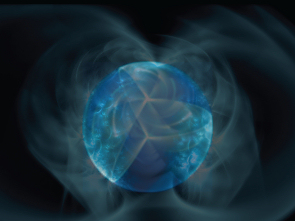Award for European scientist who solved a magnetic mystery
26 June 2014
The Committee on Space Research (COSPAR) and the Russian Academy of Sciences have nominated Nanda Rea, an assistant professor at the Institute of Space Sciences (CSIC-IEEC) in Barcelona and the Anton Pannekoek Institute (API) at the University of Amsterdam, for a prestigious Zeldovich Medal.
 |
| Nanda Rea. Credit: N. Rea |
The medal is being awarded for her valuable contribution to the study of neutron stars, and in particular for the discovery that magnetars can have low magnetic fields.
A magnetar is a type of neutron star, the dense, compact core of a giant star which has collapsed and blasted away its outer layers in a supernova explosion. Only 15 to 20 km across, their material is so compressed that a teaspoonful would weigh about a billion tonnes. As their name suggests, they have some of the strongest magnetic fields in the Universe.
At the time when Nanda Rea started her PhD studies in 2002, magnetars were believed to be steady X-ray emitters powered only by their magnetic energy. Their magnetic fields were also thought to be dipolar – resembling fields produced by a bar magnet or planet Earth.
This picture was shown to be a gross oversimplification after she began to conduct prolonged searches of the sky and long-term observations of magnetars with various space observatories, including ESA's XMM-Newton and INTEGRAL spacecraft, as well as NASA spacecraft such as Chandra, Swift, RXTE and Fermi.
The text books had to be revised when magnetars were shown to experience extreme, transient outbursts of highly energetic radiation, often in the form of X-ray flares and gamma ray outbursts. In some cases, the X-ray luminosity increased up to 1000 times before eventually subsiding once more to their quiescent level. These outbursts are caused by changes in their super-strong magnetic fields, which are hundreds or thousands of times more intense than those of the more familiar type of neutron stars, also known as pulsars.
However, the most exciting – and unexpected – discovery was an object known as SGR 0418+5729 (SGR 0418 for short), which had the lowest surface magnetic field ever found on a magnetar.
 |
| Artist's impression of a magnetar. Credit: N. Rea |
Rea's team was able to make an accurate estimate of the strength of SGR 0418's magnetic field by measuring tiny changes in its rotation speed during an X-ray outburst.
"We found that it has a surface magnetic field similar to that of ordinary neutron stars or pulsars," said Rea. "However, the star was producing flares and X-ray outbursts like other magnetars, leading us to theorise that its magnetic activity might be caused by a very strong, twisted magnetic field hidden beneath, or close to, its solid crust."
"The discovery was largely due to the prompt reaction of many X-ray satellites, and especially to the sensitivity of XMM-Newton, which has a very large X-ray collecting area, as well as good spatial and timing resolution."
By modelling the evolution of the cooling of the neutron star and its crust, as well as the gradual decay of its magnetic field, the team estimated that SGR 0418 is about 550 000 years old - older than most other magnetars.
As time has passed, the strength of its surface magnetic field has declined, but because the interior magnetic field remains relatively strong, outbursts can still occur.
These outbursts may be caused by the opening up of fractures in the crust of the neutron star under the influence of the wound-up magnetic field lurking in the interior.
Since the breakthrough with SGR 0418, Rea has discovered two more magnetars which exhibit unusually low surface magnetism.
The award also recognises her study of 'hybrid' magnetars, objects which display some characteristics of both 'normal' magnetars and radio pulsars. In these objects, the rotational energy generated by fast-spinning magnetars may be responsible for pulsed radio emissions, much like those found in pulsars.
"Several quiescent magnetars have high rotational energy," she said. "This energy might somehow power their emission at radio wavelengths, similar to normal pulsars. They are, in fact, the only magnetars that show pulsed radio emission."
This discovery makes it possible to predict if active magnetars will eventually show pulsed radio emission by a straightforward estimation of their rotational energy and quiescent luminosity.
Nanda Rea continues to study magnetars in an effort to unravel more of the mysteries associated with these exotic objects.
"Many things are still not understood about magnetars," she said. "It is a very exciting field of study. Ideas are always changing and every year there are new discoveries."
"This is an impressive example of meticulous observation with XMM-Newton and other space observatories, which has been followed up by careful theoretical analysis," said Norbert Schartel, ESA's XMM-Newton Project Scientist.
"The detection and long-term study of this new class of neutron star by Dr. Rea has contributed greatly to our understanding of these enigmatic objects."
The Zeldovich medal will be awarded during a special meeting of COSPAR, which is being held in Moscow in August 2014 to mark the centenary of the birth of the famous Russian physicist, Yakov B. Zeldovich.
More information
The Committee on Space Research (COSPAR) is an international, interdisciplinary scientific body concerned with progress in all kinds of scientific investigations carried out with space vehicles, rockets and balloons. The membership of COSPAR is composed of National Scientific Institutions or the equivalent and International Scientific Unions.
The Zeldovich Medals are conferred by COSPAR and the Russian Academy of Sciences in memory of the distinguished physicist Yakov B. Zeldovich. One medal is awarded for each COSPAR Scientific Commission. Nanda Rea's award is from Scientific Commission E: Research in Astrophysics from Space.
The European Space Agency's X-ray Multi-Mirror Mission, XMM-Newton, was launched in December 1999. The largest scientific satellite to have been built in Europe, it is also one of the most sensitive X-ray observatories ever flown. More than 170 wafer-thin, cylindrical mirrors direct incoming radiation into three high-throughput X-ray telescopes. XMM-Newton's orbit takes it almost a third of the way to the Moon, allowing for long, uninterrupted views of celestial objects.
Contact
Nanda Rea
Institute of Space Sciences (CSIC-IEEC), Barcelona, Spain
Tel: +34-935814369
and
Anton Pannekoek Institute, University of Amsterdam, The Netherlands
Email: N.Rea![]() uva.nl
uva.nl
Phone: +31-205-257472
Norbert Schartel
ESA XMM-Newton Project Scientist
Directorate of Science and Robotic Exploration
European Space Agency
Email: Norbert.Schartel![]() esa.int
esa.int
Phone: +34-91-8131-184


